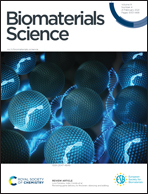Thermoplastic polyurethane with controllable degradation and critical anti-fouling properties†
Abstract
Bioresorbable polymers, including polyesters and polypeptides, are being widely used in the medical field. However, these materials still suffer from some long-standing challenges, such as material-induced blood coagulation, foreign body response, non-adjustable degradation rate, and absence of elastic properties. In this work, we explored a new approach to address these challenges by incorporating critical anti-fouling, improved mechanical and controllable degradation properties into the existing bioresorbable polymers. We synthesized a set of zwitterionic thermoplastic polyurethanes, which consist of degradable polycaprolactone diols as soft segments and faster hydrolyzable carboxybetaine (CB) diols as chain extenders. Differential scanning calorimetry and temperature sweep rheology revealed thermal transition performance and thermoplastic behavior of the polymers. The calorimetric study observed that CB-based chain extender played a critical role in the crystallization process by affecting the structure and crystallization temperature. Cell attachment study demonstrated that the degradable zwitterionic polyurethane surfaces highly resist cell attachment even after being submerged in 100% fetal bovine serum for two weeks. The gold standard PEG-based degradable polyurethane showed the initial resistance to the cell attachment for one day and then failed after three days. This work clearly shows that the adaption of existing materials with slightly better anti-fouling properties is unlikely to solve these long-lasting challenges. Our design approach and the material platform with critical anti-fouling properties and other desired tunable properties show the potential to address these complications associated with existing bioresorbable polymers. This method can be adapted to design customized bioresorbable polymers for a wide range of applications, including implantable biomedical devices and drug delivery.



 Please wait while we load your content...
Please wait while we load your content...